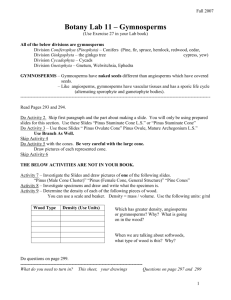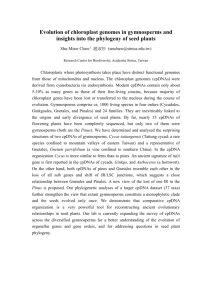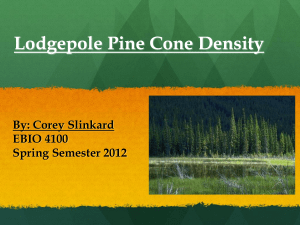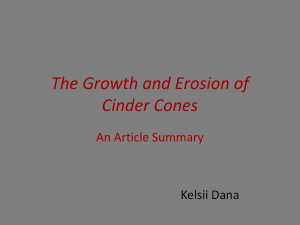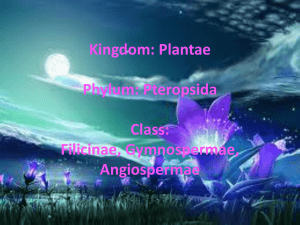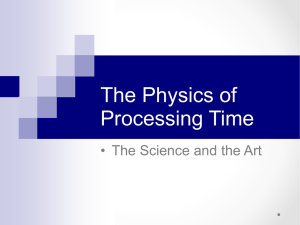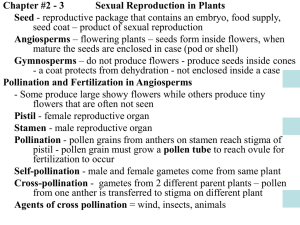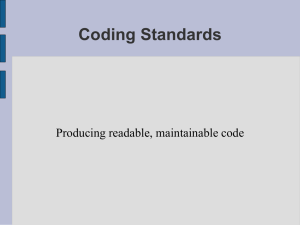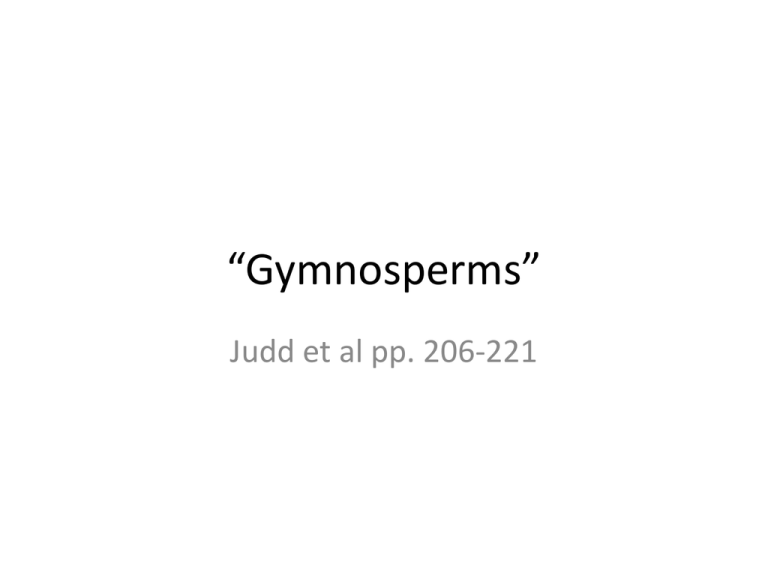
“Gymnosperms”
Judd et al pp. 206-221
Gymnosperms
•
•
•
•
•
Cycads
Gingkos (one left-- Gingko biloba)
Conifers
Gnetales
At least two extinct lineages that were
polyphyletic with regards to currently extant
gymnosperms
Cycads
• An ancient group with primitive features,
mostly southern hemisphere and endangered.
Male cones
Ginkgoales
• One member survives: Ginkgo biloba, all the rest extinct. They were
widespread 120 MYBP.
• Ginkgo biloba is possibly extinct in the wild, but used as ornamental
because it does well as a shade tree in urban environments! One of the
few plants with sex chromosomes.
“Gymnosperms” are Polyphyletic, and a small
part of the Spermatophytes (Seed Plants)
Angiosperms
(except for
Amborella)
have vessels in
the wood
Conifers in the Gila includes
both the Pinaceae and the
Cupressaceae (Junipers).
Conifers have lost the
chloroplast inverted repeat.
Gnetophytes have the
inverted repeat.
By far more
angiosperms than
gymnosperms
extant today.
“Gymnosperms”
• Needles (Pinaceae) are better adapted to drought than
broad-leaved trees. (But not all “Gymnosperms” have
needles, e.g. Gingko, Welwitschia).
• Needles also cold hardy– above ground structures
persist even in harsh environments
• Evergreen habit has drawbacks– leaf death by disease,
insects, etc., more damaging than for trees that
produce new leaves each spring (But not all
“Gymnosperms” are evergreen– e.g. Gingko)
• Gametophytes much reduced compared to ferns
“Gymnosperms”
• Swimming sperm (bryophytes, lycophytes, ferns)
replaced by dispersal of the whole male gametophyte
(pollen) except in Cycads. Naked seeds develop on the
surface of reproductive structures.
• “Seed ferns” & “Gymnosperms” are first seed plants
• Food storage tissue in seed is part of the female
gametophyte= haploid tissue. Not the same as triploid
endosperm that angiosperms have! (except in
Gnetales which have double fertilization)
“Gymnosperms”
• “All gymnosperms except the Gnetales have only
tracheids in their xylem” Gnetales have features
of both conifers (seeds not enclosed in an ovary)
and angiosperms (vessels in the wood, somewhat
flowerlike structures, & double fertilization,
inverted repeat in chloroplast)
• Conifers considered “softwood” while
angiosperm trees are “hardwood”, has to do with
whether vessel elements are present or not.
Xylem in Gymnosperms (except for
Gnetales)
Xylem: Difference between tracheids
and vessel elements
Vessel Elements (Angiosperms &
Gnetales)
Tracheids (Lycophytes, Ferns,
Gymnoserpms except Gnetales)
Wide for better water transport
Narrow for better structural support
End plate missing or perforated
Ends are tapered and pitted
Dead at maturity
Dead at maturity
Absent in “Gymnosperms” except for
Gnetales
Present in “Gymnosperms”
Gnetophytes
Ephedra trifurca
• Very reduced leaves
• Dioecious (separate male
and female plants)
• Ephedra-- Mostly desert
species
• Stems green
Welwitschia mirabilis
• Very long lived– perhaps
1500-2000 years for oldest
known specimens!
• Only two leaves grow from
the base and weather at the
ends during entire life of
plant
• Stomata on top and bottom
of leaves
Gnetophytes
Ephedra trifurca
& Gnetum, a tropical genus with broad leaves
Welwitschia mirabilis
Gnetophytes– Ephedra trifurca
Male Cones
Female Cones
From the UNM
Lab Manual by
Jane Mygatt &
Juliana Medeiros
Conifers-- Pinaceae
• Generally two ovules per cone scale.
• Inversion of the ovules, with the micropyle (passage
through integuments for pollen tube to reach ovule)
facing the axis of cone
• Wing of seed derived from cone scale. Cone scales
are modified short shoots and woody in the
Pinaceae.
• Scales are subtended by bracts.
• Largest and most economically important group of
gymnosperms (paper, building, ornamentals, etc).
• Leaves needle like and sessile or fascicled.
• Nearly all Northern Hemisphere (exception: Cedrus).
Conifers– Cupressaceae– only
represented by Juniperus in the Gila
• One to twenty ovules per cone scale, fusion of
cone scale and bract.
• Cone scales wholly adnate to bract and fleshy.
• Cones are sometimes called “berry-like” but
they are NOT berries.
• Micropyle facing away from the cone axis.
Leaves scale-like.
Conifers-- others
• Elsewhere-- hemlocks, cedars, cypresses,
redwoods, giant sequoias, yews, and others.
Giant sequoia–
Sequoiadendron
giganteum
Taxus brevifolia,
Pacific Yew, the source
of Taxol
Conifer life cycle
Cone scale;
they have
omitted the
subtending
bract
Pine pollen has two air
sacs for buoyancy in
the wind (saccae)
Frequently a sticky droplet here to
cause airborne pollen to adhere
Inverted
ovule
Pinaceae in the Gila
Abies arizonica (Cork Bark Fir)
Abies concolor (White Fir)
Picea engelmannii var. engelmannii (Engelmann's Spruce)
Picea pungens (Blue Spruce)
Pinus cembroides var. bicolor (Mexican Pinon Pine)
Pinus edulis (Pinon Pine)
Pinus leiophylla var. chihuahuana (Chihuahua Pine)
Pinus monophylla (Arizona Single Leaf Pinon)
Pinus ponderosa var. arizonica (Arizona Pine)
Pinus ponderosa var. scopulorum (Ponderosa Pine)
Pinus strobiformis (Southwestern White Pine)
Pseudotsuga menziesii var. glauca (Douglas Fir)
Fascicled
needles; cone
scales with
either
conspicuous or
inconspicuous
bracts
Picea has solitary
needles on pegs.
Abies has
upright cones in
top branches
and needles that
leave circular
scars and not on
pegs.
Twisted
petiole
gives
impression
that
needles
enter at 45
degree
angle.
Pseudotsuga menziesii
Note long,
three
pointed
bracts
below the
scales.
Pseudotsuga menziesii
Bracts in
Pinaceae
are free
from the
scale
Pseudotsuga menziesii
The wing
is derived
from the
cone
scale.
Pinus edulis
Male cones
Female
cone
Pinaceae are monoecious– both types of cones on same plant
Pinus edulis
2 ovules per cone scale
No wings on Pinus edulis seeds
Abies concolor
Abies= round scars, not pegs as in Picea
Abies concolor
2 ovules per scale, and wings derived from scale
Picea pungens
Elongate shape
Picea pungens
Pegs/pedestals
Cupressaceae in the Gila
Juniperus is dioecious, remainder of the Cupressaceae are monoecious.
Hard to remember since all we have are the dioecious Juniperus species.
Juniperus coahuilensis var. arizonica (Roseberry Juniper)
Juniperus communis var. depressa (Spreading Juniper)
Juniperus deppeana (Alligator Juniper)
Juniperus monosperma (One Seeded Juniper)
Juniperus osteosperma (Utah Juniper)
Juniperus scopulorum (Rocky Mountain Juniper)
Juniperus deppeana
Pollen cone with pollen sacs
Juniperus deppeana
Ovulate cones
From the UNM Lab
Manual by Jane
Mygatt & Juliana
Medeiros
From the UNM Lab
Manual by Jane Mygatt &
Juliana Medeiros

